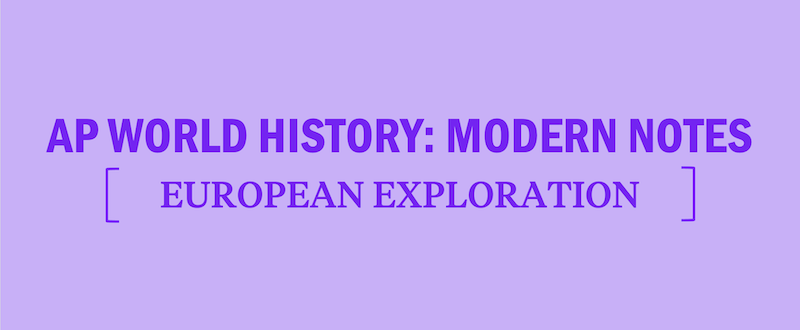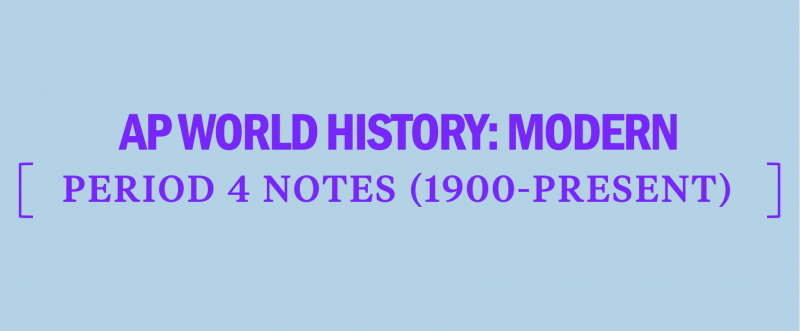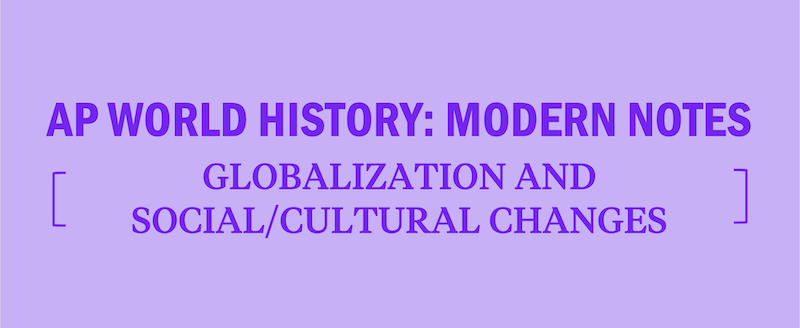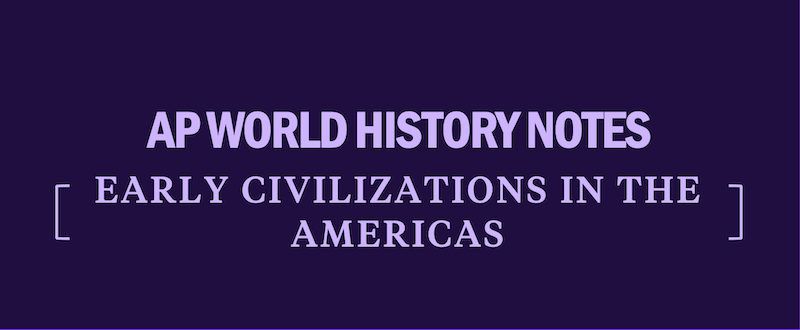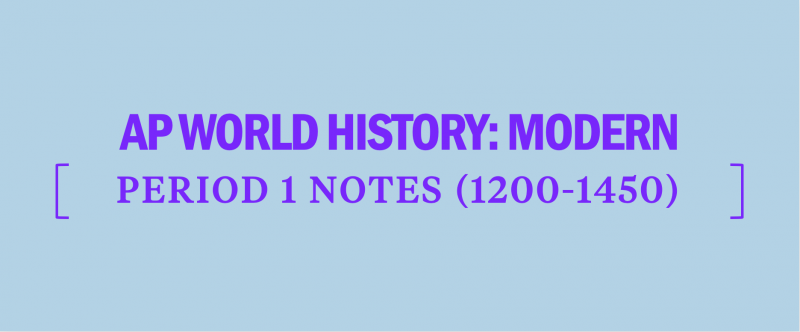European Exploration—AP World History: Modern Notes
Learning about the countries involved in European exploration and the role European expansion played in world history will help you prepare for the AP World History: Modern Exam.
Table of Contents
- European Exploration: Portugal
- European Exploration: Spain
- European Exploration: The Dutch
- European Exploration: England
- European Exploration: France
- The Development of the Global Economy
- Reaction to European Expansion
Europe emerged from an age of isolation with a desire to explore. In contrast to the Chinese, whose voyages were motivated mainly by a need to bolster their international prestige, European voyages during the Age of Exploration were motivated mainly by financial interests. The Asian goods that Europe purchased, such as pepper, ginger, cloves, and nutmeg, were significantly expensive. Europeans wanted to gain direct access to these goods, increasing supply and lowering prices. Other motives included the spread of Christianity and the desire for adventure. Read on to learn about the countries involved in European exploration and the role it played in the world.
European Exploration: Portugal
The rough landscape of Portugal was not ideal farmland, and the kingdom was an impoverished one prior to the Age of Exploration. This economic deficiency motivated interest in both accessing luxury goods more cheaply and also in improving Portugal’s finances. While the Portuguese nobility was interested in conquering Morocco, its monarchy sought to control the spice trade by finding a sea route to India. There was also interest in locating the kingdom of Prester John, a supposed Christian ruler somewhere in Africa, to form an alliance against Islam.
The Portuguese were early leaders in exploration, under the leadership of Prince Henry the Navigator, who established Portuguese schools and sponsored expeditions along the West African coast. The key innovation of Portuguese navigators was the discovery of the volta do mar (literally “turn of the sea”), trade winds that allowed ships to easily sail past the west coast of Africa. This required the counterintuitive step to sail far westward into the open ocean to catch winds that would bring ships back around to the southern tip of Africa, with Bartolomeu Dias rounding the Cape of Good Hope in 1488. The Portuguese first arrived in India in 1498; the first Indian voyage lost a third of its crew but made 60 times a return on the investment of the expedition.
The Portuguese were methodical in their exploration, carefully recording winds, sea currents, tides, port locations, and more. They conducted live trials of their cannons at sea, figuring out how to best sink enemy ships and bombard coastal targets. Despite India hosting a gunpowder The Portuguese were methodical in their exploration, carefully recording winds, sea currents, tides, port locations, and more. They conducted live trials of their cannons at sea, figuring out how to best sink enemy ships and bombard coastal targets. Despite India hosting a gunpowder empire at the time, Portuguese artillery was superior. Instead of bows, which were still in use in many places throughout Afro-Eurasia, they used crossbows and muskets and had superior armor. All these advantages allowed Portugal to establish a major, lucrative empire.
European Exploration: Spain
It is a myth that Christopher Columbus sought to prove that the Earth was round, which was a long-established fact even by 1492. Portuguese mathematicians had calculated the size of the Earth and dismissed the claim of Columbus that one could sail westward to Asia. What they were unaware of was the existence of the Americas. Spain, having just completed the Reconquista, sought a way to bypass the Portuguese monopoly on sea routes along West Africa.
While Portugal would build its empire in the Eastern Hemisphere, Spain mainly conquered the Americas. Spain did, however, conquer the Philippines, which had first been explored under Ferdinand Magellan, along with several small islands in the Pacific such as Guam.
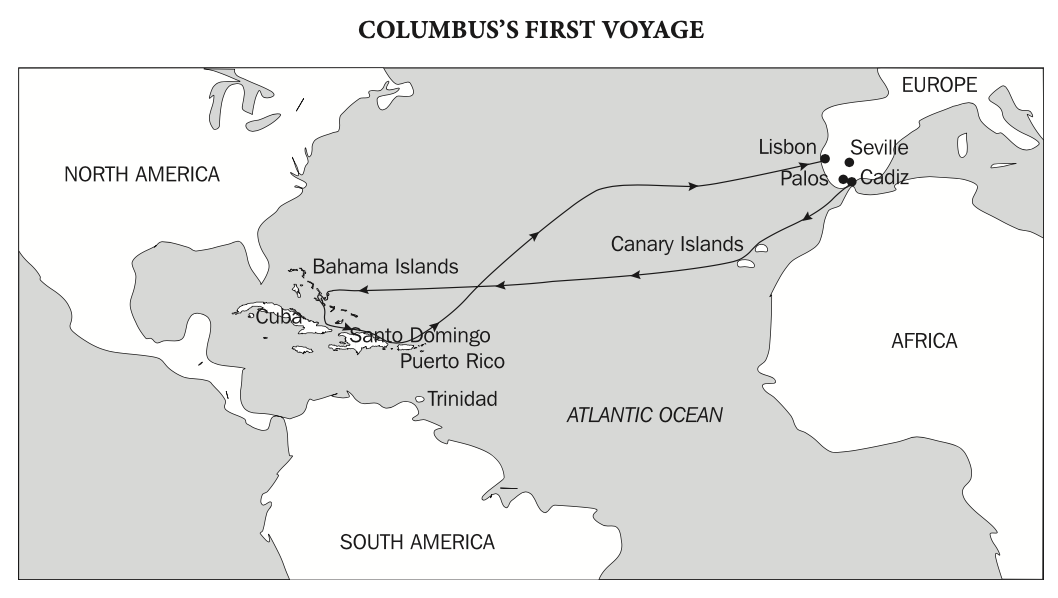
| Explorer | Year | Accomplishment |
| Bartolomeu Dias (Portugal) | 1488 | Rounded the Cape of Good Hope at the tip of Africa and entered the Indian Ocean |
| Christopher Columbus (Spain) | 1492 | Sailed west to reach Asia and instead reached the Bahamas; sailed around the Caribbean, but thought he had reached an island just off the coast of Asia |
| Vasco da Gama (Portugal) | 1495 | Reached Calicut, India, in 1498 by rounding Africa |
| Ferdinand Magellan (Spain) | 1519–1522 | Sailed around South America to the Philippine Islands where he was killed; his men sailed back through the Indian Ocean and were the first to circumnavigate the globe |
Spanish and Portuguese Colonies in the New World
Spanish conquistadors led the way in the conquest of the Americas. The primary Spanish settle- ments, New Spain (Mexico) and New Castile (Peru), were each governed by a viceroy, who reported directly to the Spanish king. In 1494, the Treaty of Tordesillas, an agreement between Spain and Portugal based on an earlier decree by Pope Alexander VI, divided control of any future American territories: the Spanish controlled the land west of the agreed-upon line of demarcation, and the Portuguese controlled the territory east of the line.
Along with its goal of increasing wealth through the creation of an empire, Spain desired to expand the influence of Christianity. Catholic missionaries came to the Americas alongside the conquistadors and built mission churches to convert American Indians, many of whom adopted Christianity but blended it with their indigenous religions. For the most part, however, these Spanish missionaries forcibly imposed European culture on the natives.
The social result of the conquest of this new empire was a multicultural and ethnically mixed population. The peninsulares, the highest social class, came directly from the Iberian peninsula, and their American-born descendants were called Creoles. Those of mixed European and American Indian descent were called mestizos, and those with European and African ancestors were called mulattos. At the bottom of the social order were the American Indians, Africans, and the mixed class of zambos.
European Exploration: The Dutch
Dutch exploration during this period is practically synonymous with the Dutch East India Company, a massive business conglomerate with monopolies in several areas, which served as the right arm of the Dutch Republic. The Dutch East India Company was a model for the British East India Company. The Dutch Empire consisted mainly of its holdings in the East Indies (present-day Indonesia), the Cape Colony (present-day South Africa), and scattered holds in the Americas, India, and China.
As with France, the high standards of living in the Dutch Republic did little to motivate citizens to emigrate abroad to colonial holdings. Some of its outposts like New Amsterdam (present-day New York City) were eventually absorbed by rival, expansionist European powers.
European Exploration: England
English voyages were mainly concentrated on North America and India. John Cabot, an Italian employed by Henry VII, explored coastal North America. Sir Francis Drake carried out the second circumnavigation of the world and was the first captain to survive the entire voyage. Unlike the other European powers, England strongly favored settler colonies. While it would eventually become a global superpower, England at the start of the Age of Exploration was a fairly impoverished sector of Europe, which motivated some people to emigrate to its overseas holdings. Its culture also associated political rights and freedom with land ownership.
While the British East India Company initially struggled against its Dutch counterpart, the British eventually gained a secure foothold in India, expanding over time until it controlled most of the subcontinent and had shut out European rivals, such as through the Anglo-Dutch Wars.
European Exploration: France
France likewise focused on the spice trade in India as well as exploration of North America. Jacques Cartier claimed much of what is present-day Canada for France and was the first European to travel inland in North America. While settlements were made in what was then called New France, the comparative wealth of France itself did not motivate much emigration to rough frontier forts and villages.
The Development of the Global Economy
Maritime Technology
The Ottoman conquest of Constantinople in 1453 ended the Byzantine Empire, solidifying Muslim influence along the Silk Road and making it less friendly to European traders. The acquisition of technology from China and the Muslim world helped Europeans expand their seagoing capabilities with maritime equipment such as the sternpost rudder, triangular lateen sails, the magnetic compass, and the astrolabe.
Portugal was an early leader in European exploration, aided by the development of the caravel, a small, highly maneuverable sailing ship. The lateen sail (French for “Latin”) dates back to Roman times, but was popularized during the Age of Exploration for its ability to let a boat tack against the wind, increasing maneuverability. This proved useful when sailing out into the Atlantic Ocean to catch the trade winds, but its size was cumbersome, especially during storms. The weaknesses of the lateen sail, and the harsh requirements of long-distance ocean travel, led to the Portuguese developing the carrack, a larger and more rugged sailing vessel with three to four masts. However, other nations innovated as well. In the sixteenth century, the Dutch developed the fluyt, a dedicated transoceanic cargo vessel that was a key factor in the rise of the Dutch Empire. At their height in the seventeenth century, fluyts carried roughly half of all European cargo.
Trading-Post Empires
The initial goal of European powers in exploring the Indian Ocean was not to conquer, but to control trade. They wanted to force merchant ships to trade in fortified trading sites and to pay duties for the privilege. By the mid 1500s, Portugal had 50 trading posts from West Africa to East Asia, but by the late 1500s its power had started to decline—the country lacked the administrative and military capabilities to keep up with other European powers. The death of King Sebastian I and a large portion of the Portuguese nobility at the Battle of Alcácer Quibir in 1578 in northern Morocco sparked a succession crisis that destabilized the country. Soon, Spain absorbed Portugal and its empire, with Portugal only regaining independence in 1640.
The English and Dutch quickly took Portugal’s place as the dominant seafaring powers with faster, cheaper, and more powerful ships. Their imperial expansion was aided by the use of joint-stock companies, in which investors, rather than royal governments, funded expeditions.
Reaction to European Expansion
Ming China
Following the voyages of Zheng He, Ming China pursued an isolationist foreign policy. While the Ming restricted European trade to islands like Macau, China still benefited enormously from the Columbian Exchange. New crops like corn and potatoes fueled population growth, offered a cushion against famine, and became staples of regional Chinese cuisine. The influx of New World silver revitalized the Chinese economy, which had suffered from inflation from an oversupply of paper money, but created a trade imbalance that would eventually lead to the Opium Wars. The enactment of the Japanese sakoku policy, as well as anti-smuggling efforts by the Spanish, disrupted the flow of silver into China, contributing to the rise of the Qing Dynasty as the Chinese economy collapsed.
Tokugawa Japan
Initially, the shogunate allowed foreign trade, which it monopolized for great financial benefit. However, European influence gradually came to be seen as a threat to the shogunate’s power structure, as foreign trade could potentially enrich the daimyo enough to allow them to unseat the shogunate. The sakoku (“closed country”), a strictly isolationist foreign policy, was enacted in 1633 and would last until 1853. Nevertheless, highly regulated contact was maintained in the city of Nagasaki with the Dutch, while the Koreans had limited contact as well. “Dutch learning” from the West primed Japan for the Meiji Restoration. The then-burgeoning Christian community in Japan was suppressed and all but wiped out.
Kingdom of Kongo
In the fourteenth century, the Kongo emerged as a centralized state along the west coast of central Africa. In this organized state, a powerful king ruled, and officials oversaw military, judicial, and financial affairs. In 1483, a small Portuguese fleet arrived and initiated commercial relations, and within a few years the Portuguese had developed a close political and diplomatic relationship with the king. To improve relations, kings like Affonso I converted to and spread Catholicism across the kingdom, although the local version of Catholicism syncretized local religion practices.
The Portuguese brought great wealth to Kongo, exchanging textiles and weapons for gold, silver, ivory, and slaves. Kongo became a major hub of the transatlantic slave trade and often sourced the slaves it forcibly exported from those captured during Kongo’s expansionist wars. Eventually, the Portuguese dealings undermined the king’s authority and led to conflict. Moreover, relations with the Portuguese would sour over time, leading to a series of wars with the Portuguese. These wars often tied into dynastic succession issues within the Kingdom of Kongo over which family—and sometimes which member within which family—should rule. The kingdom never fully recovered from these wars.

